Australian Cattle Dog
(Australian Heeler) (Hall's Heeler) (Queensland Heeler) (Blue Heeler) (Australian Cattledog) (Australischer Treibhund) (ACD)
Max, the Blue Heeler loves to heard
the goats. There will be no goat stragglers with Max around, they must all
be together in one large group. If not, Max fixes the 'problem' in a matter
of minutes!
|
Pronunciation
|
Australian Cattle Dog |
|
Description
|
The Australian
Cattle Dog, also known as the
Australian Heeler, Hall's Heeler, Queensland Heeler and the Blue
Heeler, is a
courageous, tireless, robust, compact working dog. The dog is agile,
well-muscled, powerful and determined while working. The length of the
body is
a little longer than it is tall. The tail is held moderately low
hanging at a slight curve. The front legs are straight, strong, round
bone, extending to the feet. The feet are round and the toes are short. The
skull is broad is slightly curved between the ears, flattening to a
slight but definite stop. The ears are wide-set, moderate in size, and
pricked when alert. The nose is black. The dark brown, medium-sized eyes
are oval in shape. The teeth should meet in a scissor-bite, with the
lower incisors closing behind and just touching the upper. The ACD has a
smooth double coat with a short dense undercoat. Coat colors include red speckled, blue, blue-mottled or blue speckled with or without other markings. Black markings are not desired in the show ring. Puppies are born white because of a gene they inherited from the early Dalmatian
crosses. You can sometimes tell the adult color by looking at the paw pads. |
|
Temperament
|
The Australian Cattle Dog is a loyal, brave, hardworking, herding breed.
One of the most intelligent breeds, they are not the kind of dog to
lay around the living room all day or live happily in the backyard with
only a 15 minute walk. They need much more exercise than that and
something to occupy their mind daily or they will become bored, leading to serious behavior problems.
They need action in their life and will do best with a job. This alert
dog is excellent in the obedience ring and will excel in agility and
herding trials. Can be obedience trained to a very high level. Firm
training starting when the dog is a puppy and a lot of daily leadership, along with daily mental and physical exercise will produce a wonderful and happy pet. Protective, they make an excellent guard dog. It is absolutely loyal and obedient to its
master. They are sometimes suspicious
of people and dogs they don't know. They can be very dog aggressive if allowed to be pack leader, for its
dominance level is high. Teach your Australian Cattle Dog that you are alpha
and you will not tolerate him fighting with other dogs. Well balanced
Cattle dogs are good and trustworthy with children. Some will nip at
people's heels in an attempt to herd
them and an owner needs to tell the dog this is not acceptable
behavior. If you are adopting a pet, avoid working lines, as these dogs
may
be too energetic and intense for home life. Australian Cattle Dogs
are very easy to train. Problems
can and WILL arise with meek owners, and or owners who do not provide
the proper amount and type of exercise. This breed does best with a job
to do. If you do not have time to extensively work with and exercise
your dog, or do not fully understand canine instincts and their need to have leadership, this is not the breed for you. |
|
Height, Weight
|
Height: Males 17-20 inches (43-51cm) Females 17-19
inches (43-48cm) Weight: Males 32-35 pounds (15-16kg) Females 30-35 pounds (14-16kg) |
|
Health Problems
|
Prone to hip dysplasia and PRA. The merle colored dogs are prone to deafness. |
|
Living Conditions
|
Not recommended for apartment life and does best with at least a large yard. Does best with a job to do. |
Exercise
|
These animals have incredible stamina and will enjoy all the activity you can give them. Exercise is of paramount importance - without enough they can become bored and destructive. Exercise cannot simply be tossing a ball. While they will enjoy this ball play, their brains need to be stimulated daily. Does best with a job to do. They need to be taken on long daily walks. Makes an excellent jogging companion. Do not allow this dog to walk ahead of you on the walks. He needs to be beside or behind you to re-enforce the human is alpha. |
|
Life Expectancy
|
About 12-15 years. |
|
Litter Size
|
1 - 7 - Average of 5 puppies |
Grooming
|
The short-haired, weather-resistant coat needs little care and is very easy to groom. Just comb and brush with a firm bristle brush, and bathe only when necessary. This breed tends to shed their coats once or twice per year (depending on sex status and region). |
Origin
|
Dogs the settlers
brought with them from Europe, called Smithfield and
the Old Smooth Collie (not the smooth collie known today), were
not able to handle the long distances and inhospitable climate of the new
continent. The Australian Cattle Dog was developed by pioneer
settlers in the 1800s by crossing Dingo-blue merle Collies to Dalmatians and black and tan Kelpies. Some sources say the Bull Terrier breed may have been added as well. The result were dogs who were excellent workers, herding cattle on large ranches. The dogs worked the stock quietly yet forcefully, willing and able to
drive cattle across vast distances under harsh, hot dusty conditions. With
superior stamina, it was well suited to Queensland. Both its guarding and
herding instincts are very strong.
In 1893 a man named Robert Kaleski wrote a standard for the breed. In
1903 the standard was approved in Australia. In 1980 the breed was fully
recognized by the AKC. The Australian Cattle Dog has also been known as
the Australian
Heeler, Hall's Heeler, Queensland Heeler or Blue Heeler. "Heeler"
refers to its herding skill of snapping and biting cattle's heels.
Its talents
are retrieving, herding, guarding, agility, competitive obedience,
and
performing tricks. |
Group
|
Herding, AKC Herding |
Recognition
|
APRI, FCI, AKC, UKC, KCGB, CKC, ANKC, NKC, NZKC, CKC, ACR, DRA, NAPR |
|
APRI = America's Pet Registry, Inc.
FCI = Federation Cynologique Internationale AKC = American Kennel Club UKC = United Kennel Club KCGB = Kennel Club of Great Britain CKC = Canadian Kennel Club ANKC = Australian National Kennel Club NKC = National Kennel Club NZKC = New Zealand Kennel Club CKC = Continental Kennel Club ACR = American Canine Registry DRA = Dog Registry of America, Inc. NAPR = North American Purebred Registry, Inc. |
Ozzie, the Australian Cattle Dog.
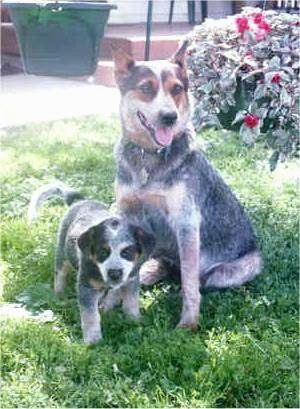
This is Jo and one of her puppies. See more of Joe on Photos Page 2. Also in The Working Aussie! Part 1 - 2
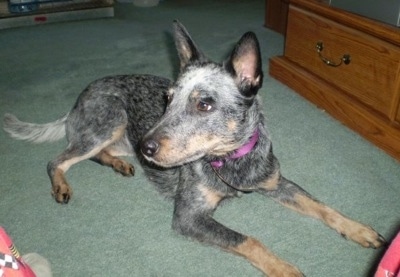
"This is Dekota, an Australian Cattle Dog at 3 years old. She is deaf and cannot hear,
but she is very happy and easy going. She does not let her deafness
stop her. Dekota and I are part of a K9 Search and Rescue team. She
loves kids, giving them kisses and playing with them."
These two Aussies are from Australia. Australian Cattle Dogs
in Australia look a little different than the American version of the breed.
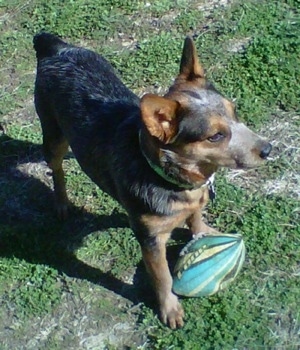
"This is Fancy. She loves to
be busy working the horses. One of the things Blue Heelers are known
for is their love of having a job to do. They have great stamina which
make them great for ranch dogs. She never gives up on me that's for
sure. I would not pick any other breed over her. She helps me on the
ranch and is great with the grand kids. She may have been born just a
Blue Heeler but Fancy is her name."
___________________________________
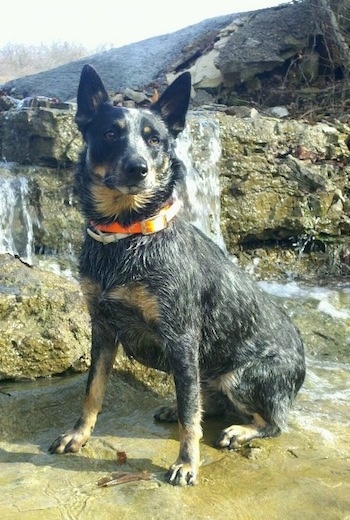
"Dually has exceeded my expectations
that I had for the ACD. He holds true to the breed standard when it
comes to stamina. This dog never gives up! He was attacked by what we
believe was coyotes
in the summer of 2011. He was missing for 3 days and showed back up all
on his own. He had massive wounds, large bite wounds that were down to
the muscles on his back right leg and his neck. He underwent 4 surgeries
over the course of 2 months and full recovery took about 3 months. To
this day you still can't slow him down. He has a very natural ability to
work cattle and
has done very well with it. I will never have another breed of dog. He
sticks beside me at all times and has gotten protective over me but only
when necessary. If mom lets someone in the house he knows that they are
a friend. We get compliments on Dually every where that we go!"
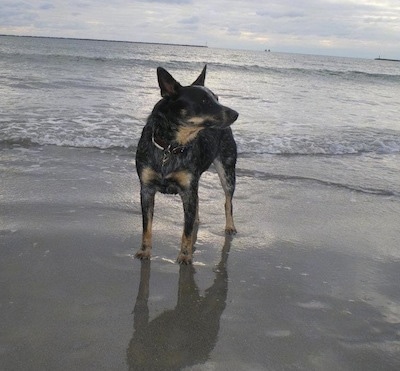
Dually the Australian Cattle Dog at 1 year old.
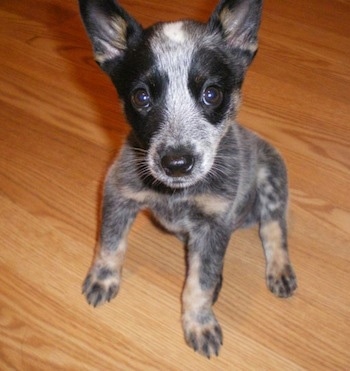
Dually the Australian Cattle Dog as a puppy.
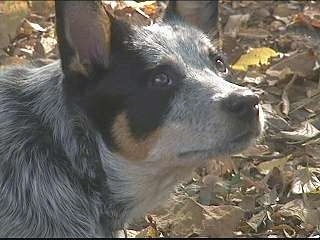
1 comentario:
http://adf.ly/Aje8m
Publicar un comentario